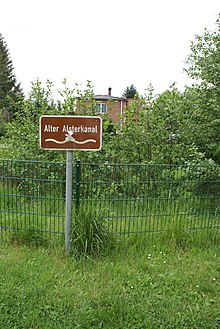Alster-Beste Canal
The Alster-Beste Canal was a navigable connection between Hamburg and Lübeck in the 16th century . It is also incorrectly referred to as the Alster-Trave Canal : the Beste and Trave rivers were navigable.
history
Since 1448 attempts have been made to create a navigable connection between Hamburg and Lübeck based on the model of the Stecknitz Canal . To this end, a canal was to connect the Alster and Beste rivers . After a contract from Hamburg with Count Adolf VIII von Holstein , construction began in the same year. After the Upper Alster was canalized, however, the operators ran out of money, so that construction had to be stopped in 1452. Hamburg, Lübeck and King Frederick I of Denmark agreed on March 14, 1525 to jointly finance the construction. However, there was legal objection to the building by Marquard von Buchwald, through whose goods Jersbek-Stegen and Borstel the canal was to be run. In addition, Magnus I of Sachsen-Lauenburg raised an objection, because he u. a. feared the decline in his customs income on the Stecknitz Canal. The construction was resumed in 1526 despite the open legal questions. By 1529 the eight kilometer long "new ditch" was built, which uses the Alte Alster ( 53.76869 ° N, 10.15273 ° E ) from Gut Stegen to the (today's) western entrance to Nienwohld , which flows into the Alster . from where the actual canal (about 4–5 km long) leads over the Nienwohlder Moor (which lies on the watershed between the North Sea and the Baltic Sea and is the highest point of the canal route) to Sülfeld , where the Norderbeste is reached ( 53.80362 ° N, 10.23444 ° E ). The Hamburg – Lübeck route was 91 kilometers long and had 23 locks . However, since the tributaries were insufficient to ensure sufficient water depth at all times, operations were restricted as early as 1549 and ceased entirely in 1550. The lock in need of repair in Neritz was not repaired that year. Detlev von Buchwaldt , lord of the manor houses Borstel and Jersbek , then had parts of the canal filled in. The canal now ends in the western Sülfeld and has no connection with the Norderbeste.
Not only the too low water level made operation impossible, but also sabotage . One landowner, annoyed by the water damage caused by the water locks, had tree trunks laid across the canal. The farmers, who had to make long detours to cultivate their fields due to the lack of bridges, were not heard with their protests.
In terms of the city's overall budget, the canal was a big bad investment by Hamburg, although some city councilors had often traveled to the Netherlands to find out about the current technology of canal construction, and well-known canal builders had been invited to Hamburg.
literature
- Alfons Meyer, Die Alster - from the natural landscape to the recreational area Hamburger Bürger , in: Mitteilungen der Geographische Gesellschaft zu Lübeck , Heft 54, Lübeck 1977, pp. 5-84
- Gerd Stolz: A brief history of the canal - from the Stecknitz Canal to the Kiel Canal. Ed. On the occasion. d. 100th anniversary d. Open d. Kiel Canal on June 21, 1895 , Boyens Buchverlag, Heide, ISBN 3-8042-0672-7
- Knut Mahrt: The Alster-Beste Canal - its remains in today's perspective. In: Mitteilungen des Canal-Verein No. 16/17, edited by Manfred Jessen-Klingenberg and Jörn Meiners, Rendsburg 1996, pp. 97–109
Individual evidence
- ↑ Volker Looks Hamburg's rights on the Alster: History of an opinion dispute in: Yearbook of the Alstervereins 2018, Hamburg 2018, pp. 35–39
- ↑ Andreas Burgmayer, Hamburger Abendblatt , May 4, 2016: Historian discovers remains of the old lock .
Web links
- History and relics of the canal
- History and historical map
- Inauguration of a hiking trail (November 2005) along the historic canal route



